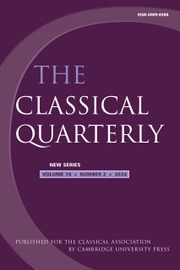No CrossRef data available.
Article contents
A NOTE ON PLINY THE ELDER (HN 9.126)
Published online by Cambridge University Press: 19 June 2025
Abstract
The article argues for an emendation in Plin. HN 9.126. Modern editors are accustomed to print the text cum testa uiuas, adopting J. Hardouin’s conjecture for cum terra uitis, the reading transmitted in most manuscripts. Nevertheless, the overlooked manuscript reading contritis conchis allows us to deduce a palaeographically neater solution contritis if conchis is considered a gloss which entered the text.
Information
- Type
- Shorter Notes
- Information
- Copyright
- © The Author(s), 2025. Published by Cambridge University Press on behalf of The Classical Association
Footnotes
The work for this note was financially supported by the grant from the Ministry of Science and Higher Education of the Russian Federation (agreement no. 075-15-2024-549 of 23 April 2024) ‘Russian and European Classical Texts in the 21st Century: Preparing Digital Academic Editions with Commentaries’.
References
1 C. Mayhoff (ed.), C. Plini Secundi Naturalis historiae libri XXXVII, vol. 2 (Leipzig, 19092), 199; H. Rackham (ed.), Pliny: Natural History, vol. 3 (London, 1940), 248; E. de Saint-Denis (ed.), Pline l’Ancien, Histoire naturelle, Livre IX (Paris, 1955), 78; R. König, G. Winkler (edd.), C. Plinius Secundus d. Ä. Naturkunde: Lateinisch–Deutsch, Buch IX (Munich, 1979), 94; A. Borghini, E. Giannarelli, A. Marcone, G. Ranucci (edd.), Gaio Plinio Secondo, Storia naturale, vol. 2 (Turin, 1983), 368.
2 J. Hardouin (ed.), Caii Plinii Secundi Historiae naturalis libri XXXVII, vol. 1 (Paris, 1741), 542; he elaborates on F. Pintianus’s earlier conjecture cum testis: F. Pintianus, In C. Plinii Historiae naturalis libros omnes … obseruationes eruditissimae … (Heidelberg, 1593), 53.
3 Contrast earlier Renaissance conjectures: cum trapetis (‘with the help of mills’, G.A. Bussi [ed.], <Plinii Naturalis historia> [Rome, 1470], 108v), trapetis (C. Plinii Secundi diuinum opus … [Basel, 1525], 163).
4 Mayhoff’s statement that R reads cum terra uiuas and Saint-Denis’s ascription of the same reading to both R and d are wrong; both manuscripts actually read cum terra uitis.
5 M.D. Reeve, The Transmission of Pliny’s Natural History (Rome, 2021).
6 Reeve (n. 5), 70–1.
7 <Plinii Naturalis historia> (Venice, 1469), 97v.
8 I presume that this was at least the case of Bussi (n. 3), who must have known the reading of the editio princeps, the only antecessor of his own 1470 edition, but prints cum trapetis, and Gelenius, who must have known the same reading contritis conchis from manuscripts belonging to the tradition of P, but prints trapetis in all of his editions from S. Gelenius (ed.), C. Plinii Secundi Historia mundi … (Basel, 1530), 163 through S. Gelenius (ed.), C. Plinii Secundi Historiae mundi … (Basel, 1554), 161. By the time editors started to list variant readings (as in J. Dalechamps [ed.], C. Plinii Secundi Historiae mundi … [Lyon, 1587] and Hardouin [n. 2]), the reading contritis conchis fell into such oblivion that it does not even receive a mention.
9 W.M. Lindsay, Notae Latinae: An Account of Abbreviation in Latin MSS. of the Early Minuscule Period (c. 700–850) (Cambridge, 1915), 41–2, 324.
10 Lindsay (n. 9), 309. The hyparchetype of the more widespread family must date before c.800, the date of MS D, its earliest member here (L.D. Reynolds, ‘The Elder Pliny’, in L.D. Reynolds [ed.], Texts and Transmission: A Survey of the Latin Classics [Oxford, 1983], 307–16, at 311; Reeve [n. 5], 19), but it is perhaps not very difficult to imagine that an abbreviation used in 811 was also used some twenty years earlier.
11 The main variants are perhaps an attempt to make sense of the letters itis and a correction a added to tr to make the abbreviation easier to decipher and then misunderstood owing to the ‘open’ graphics of the letter.
12 Cf. e.g. Plin. HN 37.155 melle enim colluto ore inpositam linguae futurorum diuinationem praestare promittunt XV luna et silente toto die, decrescente uero ante ortum solis ‘For they claim that the stone [“chelonia”], if it is placed on the tongue after the mouth has been rinsed with honey, confers powers of prophecy—at full moon or new moon, during the whole of the day; when the moon is waning, before sunrise only’ (transl. D.E. Eichholz).
13 Cf. also instances where the correction of F2 might have been influenced by the reading of the family of P but certainly does not reproduce it, since it retains many of the errors of the more widespread family: e.g. HN 8.166, where P has the true reading obuersas and even R before correction reads obuersus, but F before correction follows D in reading aduersus, and F2 corrects to aduersas; 8.169 in cubitu laxitas PL2 (the true reading), incubit alaxitas DR, incubitus alaxitas F2.


